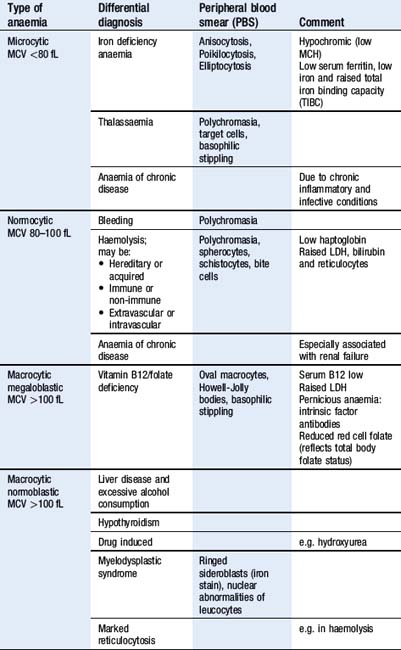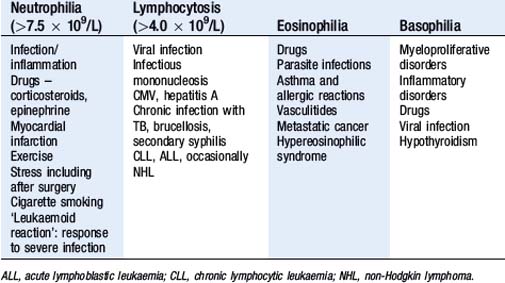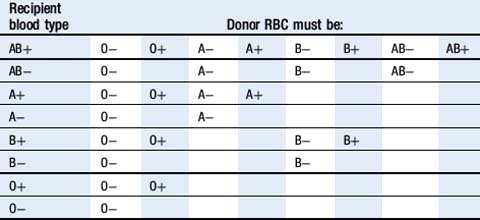TOPIC 7 Haematology and coagulation
Laboratory tests of coagulation 137
Common first tests
Test: Full blood count and peripheral blood smear (PBS)
Indications
• To show abnormalities in the production, life span, and destruction of blood cells and aid in the diagnosis of anaemia, polycythaemia, thrombocytosis, thrombocytopenia, leucopaenia and leucocytosis.
How it is done
Interpretation
| Male | Female* | |
|---|---|---|
| Haemoglobin (g/dL) | 13–18.0 | 11.5–16.5 |
| RBCs (×1012/L) | 4.5–6.5 | 4.0–5.8 |
| Hct (%) | 0.40–0.52 | 0.37–0.47 |
| MCV (fL) | 84–96 | 84–96 |
| MCH (pg) | 27.0–32.0 | |
| MCHC (g/dL) | 27.0–32.0 | |
| Platelets (×109/L) | 150–400 | |
| WBCs (×109/L) | 4.0–11.0 | |
| Neutrophils (×109/L) | 2.0–7.5 | |
| Lymphocytes (×109/L) | 1.5–4.0 | |
| Monocytes (×109/L) | 0.2–0.8 | |
| Eosinophils (×109/L) | 0.04–0.4 | |
| Basophils (×109/L) | 0.0–0.1 | |
| Reticulocytes (% or 109/L) | 0.5–2.5 or 20–80 |
* In pregnancy the Hb may fall as low as 9 g/dL in the third trimester. RBCs, red blood cells; Hct, haematocrit; MCV, mean cell volume; MCH, mean cell haemoglobin; MCHC, mean corpuscular haemoglobin concentration; WBC, white blood cell.
Abnormalities
Polycythaemia: Increased haemoglobin/haematocrit
| True polycythaemia | Secondary polycythaemia | Apparent or spurious polycythaemia |
|---|---|---|
| Polycythaemia rubra vera, (PRV) | Inappropriate erythropoietin secretion in benign & malignant renal disorders and by some tumours | Secondary to cigarette smoking, obesity, excess alcohol or hypertension |
Leucopenia: WBC <4.0 × 109/L
| Neutropenia | Lymphopenia | |
|---|---|---|
| Congenital causes | Acquired causes | |
Leucocytosis
Detection of a leucocytosis by the automated counter needs confirmation with a PBS and manual count. See Table 7.7.
Management principles
• The full blood count is often performed unnecessarily as a preoperative screening tool. Various studies have shown that this is a waste of resources although some would argue that it is indicated in all premenopausal women because of the higher incidence of anaemia.
Limitations and complications
Test: Group and screen/crossmatch
Indications
How it is done
• ‘Group’ – determines which ABO and Rh antigens are present on patient’s red blood cells (RBCs). RBCs are incubated with commercially available antibodies (anti-A, anti-B), which react with antigens if present and cause agglutination. The patient’s serum is then incubated with A and B cells to determine the presence of anti-A and anti-B antibodies. (See Table 7.8)
• ‘Screen’ – utilizes the indirect Coomb’s test (indirect antiglobulin test). Serum is incubated with a wide range of RBCs that together exhibit a comprehensive range of surface antigens. If antibodies are present they will cause agglutination.
• Crossmatch – may be electronic or serological. An electronic crossmatch is used in uncomplicated cases with a negative antibody screen. A serological crossmatch requires RBCs from the donor unit to be incubated with the patient’s serum, which will cause agglutination if the unit is not compatible.
Interpretation
Physiological principles
• Blood type is determined by the presence or absence of inherited antigenic material on the surface of RBCs; the ABO blood group system and Rh blood group system are the two most likely to cause harmful immunologically mediated reactions if noncompatible blood is transfused.
Management principles
• ABO compatibility. When considering blood group compatibility for transfusion it is the recipient antibodies and donor antigens that are important. For example, group AB individuals have A and B antigens on the surface of their RBCs; their blood serum does not contain any antibodies against either A or B antigen so they can receive blood from any group (in theory, AB being preferable). Blood group O individuals have neither antigen but both anti-A and anti-B antibodies therefore will cause agglutination of the donor RBCs if they are given anything other than group O blood (Table 7.9).
• Rhesus compatibility. An RhD-negative patient with no antibodies could only receive RhD-positive blood once, as this would lead to the formation of antibodies and potentially hazardous transfusion reactions if they were to receive it again. If an RhD-negative woman develops antibodies and becomes pregnant with an RhD-positive child, these antibodies can cross the placenta and cause haemolytic disease of the newborn. Therefore rhesus-positive blood or platelets should never be given to RhD-negative women of childbearing age or patients with rhesus D antibodies. Platelets can be given with anti-D cover in emergencies.
• Plasma compatibility. Donor-recipient compatibility is the opposite of blood compatibility. Type O plasma (fresh frozen plasma, FFP) can only be given to type O recipients; Type AB can be given to individuals of any blood group (Table 7.10).
• There are usually local policies in place for the routine ordering of preoperative G&S or crossmatched blood that take into account the planned surgery, estimated blood loss and need for transfusion.
| Recipient blood type | Donor plasma must be: |
|---|---|
| AB | AB |
| A | A or AB |
| B | B or AB |
| O | O, A, B or AB |
Laboratory tests of coagulation
Tests: Prothrombin time (PT)/international normalized ratio (INR), activated partial thromboplastin time (APTT) and thrombin time (TT)
Indications
How it is done
• PT/INR – thromboplastin and calcium added to PPP and time to fibrin formation measured by a photo-optical or electromechanical device; this equals the prothrombin time (PT). To standardize results the PT is compared to a reference value, which gives the INR.
• APTT – PPP, phospholipid and calcium are added to kaolin and the time to fibrin formation measured.
Buy Membership for Anesthesiology Category to continue reading. Learn more here










